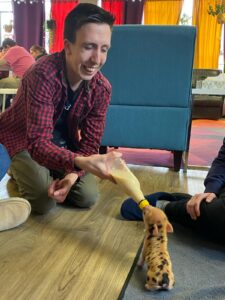Terrariums are miniature gardens housed in glass containers, creating a beautiful and self-sustaining ecosystem. They are not just aesthetically pleasing but also offer therapeutic benefits. Building a terrarium can be particularly rewarding for adults with developmental disabilities, as it encourages creativity, enhances fine motor skills, and instills a sense of accomplishment and responsibility. Here’s a comprehensive guide to help you or your loved one create a beautiful terrarium at home.
Understanding Terrariums
Before diving into the creation process, it’s essential to understand what a terrarium is. A terrarium is a glass container that houses soil and plants, creating a miniature ecosystem. They can be sealed or open and are perfect for growing a variety of small plants. Terrariums replicate a natural environment, providing a glimpse of nature inside your home.
Choosing the Right Container
The first step in creating a terrarium is choosing the right container. This can vary greatly depending on the type of terrarium you want to create.
Size: Containers can range from small jars to large aquariums. A good starting point is a container that can comfortably sit on a tabletop.
Shape: While the shape can be anything from spherical to rectangular, ensure that the opening is wide enough for your hand to fit through for easy maintenance.
Material: Glass is the preferred material as it is transparent and helps in observing the growth and health of the plants.
Types of Terrariums
There are generally two types of terrariums:
Closed Terrariums: These are ideal for moisture-loving plants. They have a lid and create a humid environment.
Open Terrariums: Best suited for plants that thrive in dry conditions, such as succulents.
Selecting Plants
The choice of plants depends on the type of terrarium you are creating:
For Closed Terrariums: Opt for moisture-loving plants like ferns, mosses, and air plants. Examples include the Nerve Plant (Fittonia), Spider Fern, and Moss.
For Open Terrariums: Choose plants that prefer a drier environment, such as succulents and cacti.
When selecting plants, consider their growth habits. Slow-growing, dwarf varieties are best as they will remain a manageable size.
Materials Needed
Gather the following materials before starting your terrarium:
Glass container
Gravel or small stones for drainage
Activated charcoal (optional, but recommended for closed terrariums)
Potting soil suitable for the plants you’ve chosen
Plants
Decorative elements like figurines or shells
Watering can or spray bottle
Gloves and small shovel or spoon
Step-by-Step Guide to Creating Your Terrarium
Prepare the Container: Clean your container thoroughly to ensure it’s free from dust and dirt.
Create a Drainage Layer: Add a layer of gravel or small stones to the bottom of the container. This should be about one to two inches deep, depending on the size of your container.
Add Charcoal: If using activated charcoal, sprinkle a thin layer over the gravel. This helps prevent water from becoming stagnant.
Add Soil: Pour in enough potting soil to cover the roots of your plants. The amount will vary based on the size of your container and the type of plants you’re using.
Planting: Dig small holes in the soil and plant your selections. Arrange the taller plants in the back and shorter ones in the front. Ensure they’re spaced well and not overcrowded.
Add Decorations: Place your decorative elements in the terrarium. This is a great opportunity to personalize your terrarium.
Water Your Plants: Use a spray bottle or small watering can to moisten the soil. Be cautious not to overwater, especially in a closed terrarium.
Close or Leave Open: If you have a lid and are creating a closed terrarium, you can place the lid on now. For open terrariums or if using succulents, leave the terrarium open.
Find the Right Spot: Place your terrarium in a location where it will receive indirect sunlight. Avoid direct sunlight as it can heat the terrarium and harm the plants.
Maintenance Tips
Watering: Closed terrariums need very little watering as they recycle water. Open terrariums will require more frequent watering, but be careful not to overwater.
Pruning: Trim any overgrown plants to keep your terrarium looking neat and prevent overcrowding.
Cleaning: Wipe the inside and outside of the glass occasionally to maintain clarity.
Monitoring: Watch for signs of distress in plants and adjust care as needed.
Benefits of Creating a Terrarium
Building a terrarium offers numerous benefits for anyone but can specifically help build and maintain skills for adults with developmental disabilities:
Enhances Motor Skills: The process of placing plants and arranging decorations in the terrarium helps improve fine motor skills.
Promotes Learning: Caring for a terrarium teaches responsibility and helps in understanding plant life and ecosystems.
Therapeutic: The act of gardening, even on a small scale, is known to be calming and can reduce stress.
Sense of Accomplishment: Successfully creating and maintaining a terrarium provides a tangible sense of achievement and pride.
Aesthetically Pleasing: A terrarium is a beautiful addition to any room, bringing a bit of nature indoors.
Customizing Your Terrarium
Encourage creativity by customizing the terrarium. This can be done through:
Themed Decorations: Choose a theme for the terrarium, like a fairy garden, desert oasis, or a miniature forest.
Seasonal Variations: Decorate the terrarium according to seasons or holidays, like adding miniature pumpkins during fall or tiny ornaments during the winter holidays.
Unique Containers: Beyond traditional glass jars, consider unique containers like old fish tanks, light bulbs, or even teapots.
Safety Precautions:
When creating a terrarium, it’s important to keep safety in mind:
Supervision: Depending on the level of ability, some additional supervision and/or assistance may be required, especially with tasks like cutting or handling fragile plants.
Non-Toxic Plants: Ensure that all plants used are non-toxic and safe to handle.
Safe Tools: Use tools that are safe and easy to handle or are appropriate for the individual’s skill level and safety needs.
Building a terrarium is a simple, yet deeply rewarding project that can help build skills, confidence, pride and increase independence for adults with developmental disabilities. It not only adds a touch of greenery to an environment but also offers a sense of responsibility and accomplishment. By choosing the right plants, container, and decorations, and by following these steps, a thriving miniature garden can be created. This activity not only beautifies the living space but also enriches the lives of those who partake in it, making it a fulfilling and enjoyable experience.
Through the creation and care of a terrarium, an outlet that is both manageable and satisfying can be created. It’s an activity that combines learning, creativity, and the therapeutic benefits of connecting with nature. Whether done independently or with assistance, building a terrarium is a wonderful way to engage and inspire.




